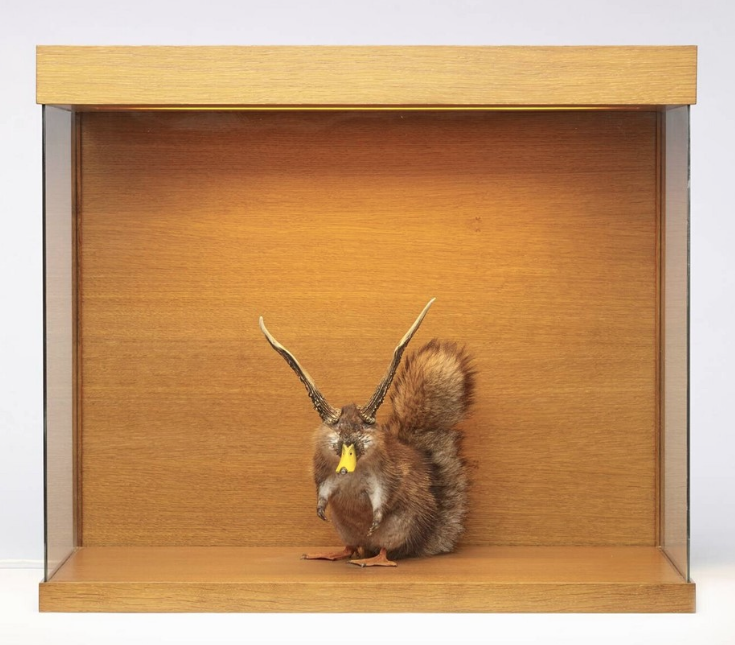Difference between revisions of "User:T.tran"
| Line 16: | Line 16: | ||
Thomas Grünfeld is best known for his “Misfits”—sculptures made from taxidermied animals. Grünefeld’s animals, however, subvert the typically scientific nature of taxidermy and instead represent fictional creatures: He places a pig’s head on a bird’s body in Misfit (pig/bird) (2001), or a dog’s head on the body of a calf in Misfit (doberman) (1998). The works reference German folklore, specifically children’s wolperfinger—moralizing fables about human-like animals—and as such evoke proverbial battles between real and imaginary, good and evil. | Thomas Grünfeld is best known for his “Misfits”—sculptures made from taxidermied animals. Grünefeld’s animals, however, subvert the typically scientific nature of taxidermy and instead represent fictional creatures: He places a pig’s head on a bird’s body in Misfit (pig/bird) (2001), or a dog’s head on the body of a calf in Misfit (doberman) (1998). The works reference German folklore, specifically children’s wolperfinger—moralizing fables about human-like animals—and as such evoke proverbial battles between real and imaginary, good and evil. | ||
([[Artsy.net|https://artsy.net/artist/thomas-grunfeld]]) | ([[Artsy.net|https://artsy.net/artist/thomas-grunfeld]]) | ||
| + | |||
| + | neither historically accurate nor a restoration of anything that ever existed, Grunfeld's new trophies are assembled bij combining parts from different animals, made to looks as plausible as possible - as plausible, at least as a narwal, a stick-insect or a platypus. numbered, not titled, the '''misfits''' look lost and vulnerable in their cabinets of german oak -'lost' because the cases are obviously too big, 'vulnerable' because of the neon lights and glass in three sides. their cole function is to be displayed like specimens, and their disturbing air of self-consciousness may derive from this fact, admittedly, they differ. While parts of a rabbit and a pheasant and the teeth of a fox give III a classical air, VI and V seem humorous and visually appealing. | ||
| + | |||
| + | Grunfeld's misfits related to the Southern German Wolpertinger tradition, tall tales about improbable beasts lurking unsuspected in the wild. Neither drawings and descriptions of these animals nor concocted specimens serve to increase their credibility. Instead, they further the mythology surrounding them, a phenomenon which even moves into print with popular books such as '''Heim''' and '''Reiser's Mit den Wolpertiner leben''' or '''Alphons schweigert's Und es Gibt sir doch'''! | ||
| + | |||
| + | |||
=='''Inspiration'''== | =='''Inspiration'''== | ||
=='''Replica of Misfit IV'''== | =='''Replica of Misfit IV'''== | ||
Revision as of 08:08, 18 September 2014
Contents
Me, me, me: THUAN TRAN
Take and Make form the Museum
Project 1: Museum Of Fantastic Forgeries
For my first project I took inspiration from the art work of Thomas Grunfeld; name: Misfit IV. It is a series of sculptures made from taxidermic animals. I chose it because of the techniek, materials and specially de stories that he wants to tell us.
Misfit IV (Misbaksel IV), 1989 - 1990
Thomas Grünfeld
Biography
Thomas Grünfeld is best known for his “Misfits”—sculptures made from taxidermied animals. Grünefeld’s animals, however, subvert the typically scientific nature of taxidermy and instead represent fictional creatures: He places a pig’s head on a bird’s body in Misfit (pig/bird) (2001), or a dog’s head on the body of a calf in Misfit (doberman) (1998). The works reference German folklore, specifically children’s wolperfinger—moralizing fables about human-like animals—and as such evoke proverbial battles between real and imaginary, good and evil. (https://artsy.net/artist/thomas-grunfeld)
neither historically accurate nor a restoration of anything that ever existed, Grunfeld's new trophies are assembled bij combining parts from different animals, made to looks as plausible as possible - as plausible, at least as a narwal, a stick-insect or a platypus. numbered, not titled, the misfits look lost and vulnerable in their cabinets of german oak -'lost' because the cases are obviously too big, 'vulnerable' because of the neon lights and glass in three sides. their cole function is to be displayed like specimens, and their disturbing air of self-consciousness may derive from this fact, admittedly, they differ. While parts of a rabbit and a pheasant and the teeth of a fox give III a classical air, VI and V seem humorous and visually appealing.
Grunfeld's misfits related to the Southern German Wolpertinger tradition, tall tales about improbable beasts lurking unsuspected in the wild. Neither drawings and descriptions of these animals nor concocted specimens serve to increase their credibility. Instead, they further the mythology surrounding them, a phenomenon which even moves into print with popular books such as Heim and Reiser's Mit den Wolpertiner leben or Alphons schweigert's Und es Gibt sir doch!
